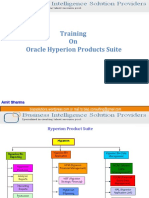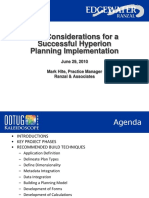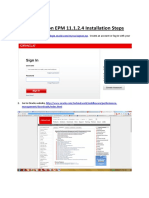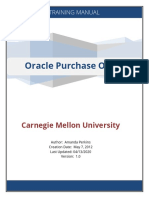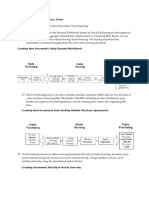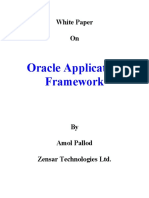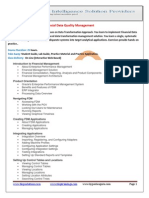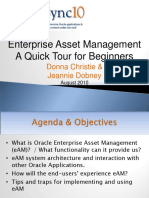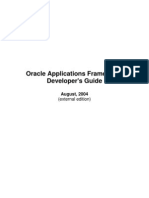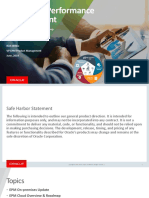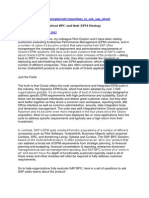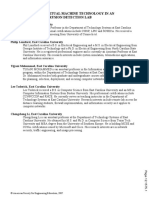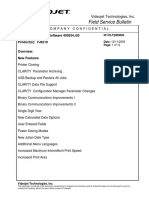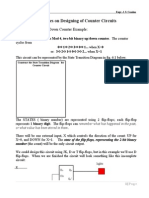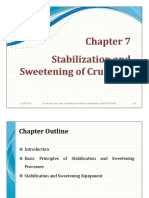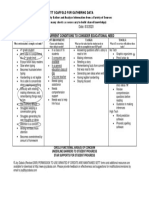Competitive Brief: Oracle - Hyperion
Who: Oracle
Founded: 1977 Headquarters: Redwood City, CA Employees: 115,000 Revenue: $37B
What:
Hyperion EPM applications
�Financial Excellence enabled by the market leader SAP #1 for finance A global install base in the office of finance
Over 57,000 ERP Financials and Business One customers
Over 6,000 Enterprise Performance Management customers
25.8%
22.4% 14.5%
12.0%
#1 for ERP*
6.8%
#1 for BI, EPM and Analytic Applications** CPM Suites Magic Quadrant 2010
12.2%
�SAP has the Momentum.. EPM Market Share
�Momentum SAP Has Strongest Current Offering
�Why BPC?
Unified Solution vs. Disparate Technologies
BPC is a single platform for reporting, planning and financial consolidations Hyperion is a multi-platform provider for reporting, planning and financial consolidations
Hyperion has separate databases for Planning (Hyp. Planning or Essbase) and Cons (HFM)
Requires you to push and pull data in batch jobs to load data into each Hyperion module from each data source Metadata (e.g., hierarchies) must transferred between the separate modules
You cannot transfer business rules / logic from Planning to Cons
Hyperion Planning can only use Essbase Hierarchies Hyperion Financial Management requires business rules and hierarchies to be developed in Visual Basic script programming, runs on Oracle, SQL, or DB2
Separate vs. Shared Dimension Structures
Hyperion = separate dimension structures requires synchronization of data between modules BPC = shared dimension structure when you add a category, it appears in all applications reducing level of administration maintenance and database size
The Value of BI
SAP delivers out-of-the-box integration to industrys #1 BI tools
�A history of successful Hyperion replacements
Over 400 companies have switched from Hyperion since SAP acquired OutlookSoft. What customers consistently say is that Hyperion Has high cost of ownership because of separate apps for planning & consolidation. Have you analyzed your administration, maintenance, training and support costs? Customers say that performing a return on investment analysis made it easy for them to justify replacing Hyperion. Is complex to install because Hyperion Planning and Financial Management are separate applications that use different technology stacks This means more separate components to install and configure and higher maintenance workloads. SAP BPC has a single application for planning, consolidations and reporting built on a unified services oriented architecture (SOA) Has weak workflow capabilities Would you like model workflow across planning, consolidation and reporting processes; Manage workflow based on more than 3 dimensions; Or link the Hyperion Excel interface to task lists? Customers say that moving from Hyperion enabled them to create more efficient processes that increased business productivity.
�Oracle Planning and HFM are completely different applications
Oracle claims that EPM Architect helps to unify them, while they share some similar components the applications are separate, have different user experiences and require mapping of data for integration.
This requires you to push and pull data in batch jobs to load data into each Hyperion module from each data source.
Metadata (e.g., hierarchies) must transferred between the separate modules HFM and Planning applications use different calculation engines
the Calculation Manager interface is a common UI to create rules but you cant share calculations across applications (HFM and Planning) and the actual deployed rules use different processing engines, VBScript for HFM and calc script for Planning.
HFM and Planning are developed by different development teams. Planning has a completely different forms interface, workflow engine and very limited shared functionality Workflow functionality is completely different between the two applications Hyperion = separate dimension structures requires synchronization of data between modules
BPC = shared dimension structure when you add a category, it appears in all applications reducing level of administration maintenance and database size
Oracle has no SAP-Certified integration requiring a 3rd party adapter to get data out of SAP
�What is the Strategic Direction for Oracle EPM?
What truly new features have been released in HFM in the past release? Is the migration direct from 9.3 or do you have to install prior release packs to get to 11.1.2? What are the additional server and memory requirements with moving to 11.1.2? What is the future of Hyperion Shared Services technology? Will Planning and HFM be replaced by new Fusion applications? If they are rewritten on Fusion technology they will be built to leverage Oracle ERP not SAP ERP Oracle Plannings new process management functionality in Planning 11.1.2 was developed using non-fusion technology components SAP BPC is designed and optimized for SAP customers Reimplement? HFM is a windows based application. The Fusion platform is not. Are customers who migrate to 11.1.2 facing another migration in short order?
�Hyperion Financial Management Update
The latest release of HFM (11.1.2.2) allows for configurable dimensions. No longer limited to 4 Dimensions Now applications can be designed to more closely mirror Oracle Essbase or Oracle Hyperion Planning applications, simplifying the movement of data between the applications. It will also be possible to add dimensions to an existing application. Depending upon what is being added, after upgrading to release 11.1.2.2, it may be possible to add dimensions without rebuilding the application.
�What Oracle/Hyperion Will Say.
BPC is weak in consolidations
Organization by period (minority interest, JV, complex consolidations) Add complexity around the close process using value engineering & onsite discovery
Planning vs. BPC is typically a wash especially in SAP shops.
End users prefer the UI for BPC over Hyperion Planning Stress FUD around scalability
Position Strategic Finance as a differentiator Position Data Relationship Management (DRM) for hierarchy/metadata management Recent success with SAP client base to use to pull structures from SAP and move to Hyperion SAP has limited references for BPC
�Respond to the FUD
BPC is weak in consolidations
Organization by period (minority interest, JV, complex consolidations) Add complexity around the close process using value engineering & on-site discovery
REALITY: BPC 7.5 is functionally equivalent but poorly highlighted by demo scenarios. EPM 10 delivers out of the box best in class consolidation functionality Planning vs. BPC is typically a wash especially in SAP shops.
End users prefer the UI for BPC over Hyperion Planning Stress FUD around scalability
REALITY: BPC delivers the flexibility, functionality & familiarity of Excel. Fortune 500 companies such as Colgate, Flextronics, Dow Chemical do planning for a large user base. Position Strategic Finance as a differentiator REALITY: HSF is a point solution that was developed > 10 years ago. The average user size is 2..minimize value SAP has limited references for BPC REALITY: Not true. 100+ customers in SAP reference program & a significant number of untapped partner references available
�Application Overview
�Oracle Performance Management Applications Strategic Products
DOMAIN
Strategic Planning
PRODUCTS
Hyperion Performance Scorecard Hyperion Strategic Finance Oracle Crystal Ball Hyperion Planning Hyperion Workforce Planning Hyperion Capital Asset Planning Oracle Integrated Operational Planning Hyperion Financial Management Hyperion Financial Data Quality Management Oracle Hyperion Profitability and Cost Management, (July 2008) PeopleSoft Activity Based Management Oracle EBS Profitability Management Oracle OFSA
Planning & Budgeting
Financial Close Management Cost and Profitability Management
�Oracle Performance Management Applications Continued Support
DOMAIN
Strategic Planning Planning & Budgeting
PRODUCTS
Oracle Balanced Scorecard PeopleSoft Scorecard Oracle Financial Analyzer Oracle Ent. Planning & Budgeting PeopleSoft Planning & Budgeting Hyperion Pillar Hyperion Enterprise Oracle Financial Consol. Hub PeopleSoft Global Consolidations Oracle EBS Activity Based Management Hyperion Business Modeling
Financial Close Management
Cost and Profitability Management
Continued SupportCODE WORD For No longer developed
�Comparison: BPC to Oracle Planning Apps
Evaluation Criteria SAP Business Planning Hyperion Pillar Hyperion Planning Planning End-User Functionality (Appearance & Ease of Use, Requires Little Training, Easy Integration with Business User Data, Appealing End User Experience)
Planning Configuration/Setup/Admin by Finance Analyst (not IT) (Large portions of system administration, such as dimensional selection, forms authoring, data element additions, formatted reporting, etc. can be conducted without IT support)
Planning Engine Functionality (Offline Planning, Forecasting, Reconciled Top-Down and Bottom-Up Planning, Allocations, Driver-Based Planning, Pre-Packaged Applications, Planning Functions)
Enhanced Features (Business Process Flows, Automated variance analysis, Predictive analytics)
Technology (Offline capability, Unified Platform, Language & Unicode support, Scalability, SOA)
Installation and Configuration
Integration (NW compatibility, Single KPI repository, Open to distinct data sources)
No integration No integration with SAP with SAP
�Comparison: BPC to Oracle Consolidation Apps
Evaluation Criteria SAP Business Consolidation Hyperion Enterprise Hyperion HFM Consolidation End-User Functionality (Appearance & Ease of Use, Requires Little Training, Easy Integration With Business User Data, Appealing End User Experience)
Consolidation Configuration/Setup/Admin by Finance Analyst (not IT) (Large portions of system administration, such as dimensional selection, forms authoring, data element additions, formatted reporting, etc. can be conducted without IT support)
Consolidation Engine Functionality (Consolidation Types, Accounting Techniques, Consolidations Monitor, Workflow, Manual Postings, InterUnit Elimination, Capitalisation and Value Allowance, Consolidation of Investments, Allocations)
Technology (Offline capability, Unified Platform, Language & Unicode support, Scalability, SOA)
Installation and Configuration
Integration (Ability to leverage NW, NW certified integration, Single KPI repository, Open to distinct data sources)
No integration with SAP
No integration with SAP
�Oracle/Hyperion means more applications, more hardware
Hyperion Financial Management (Min) Hyperion Planning (Min) Hyperion Disclosure Management SAP BusinessObjects Planning & Consolidation SAP BusinessObjects Disclosure Management
Hyperion Data Integration Mgmt.
Hyperion Capital Asset Planning
Hyperion Strategic Finance
*MS SQL/AS OLAP DB for non SAP clients
Hyperion Data Relationship Mgr.
Hyperion Workforce Planning
Hyperion Essbase
�FOR SAP ERP/NetWeaver BW Customers
�10 reasons why SAP BusinessObjects Planning and Consolidation, version for SAP NetWeaver* is designed and optimized your SAP landscape
Feature/Capability 1 2 3 4 5 6 7 8 9 10
More deeply integrated with SAP NetWeaver than any other vendors offerings - gap widens as further integration takes place in subsequent releases Replicates data in the same SAP NetWeaver BW system with option to use SAP NetWeaver BW ETL* 3rd party applications replicate data outside of NetWeaver using 3rd party ETL or flat files typically using non-certified APIs Native integration with the SAP NetWeaver BW OLAP Engine as opposed to flattening data out and recreating hierarchies in a separate OLAP engine (ex Essbase or TM1)**
Benefit
Leverage existing SAP infrastructure, applications, workflows, and skill sets with you planning and consolidation application(s) leading to a lower cost of ownership and better performance One common SAP NetWeaver BW system for enterprise-wide data warehouse and planning purposes leads to a lower cost of ownership in addition to alleviating security concerns of moving data outside of BW No master data challenges that are caused by feeding flat files from SAP NetWeaver BW through to a 3rd party OLAP engine
Application content (ApShell) delivered as SAP BusinessObjects Planning and Consolidation business content
All SAP BusinessObjects Planning and Consolidation files are stored in the NW Database with available Integrated VirusScan Load data into SAP BusinessObjects Planning and Consolidation from ERP via NW BW ETL***
Delivered vs Active versions of business content allow for updates to Delivered versions without impacting the Active Versions
No separate file system required contributing to lower TCO Avoids incorrect results that can occur by bypassing Service API logic, which is the route many 3rd party vendors applications take
Tightly knit with the SAP BusinessObjects Intelligence Platform for best in class query, reporting , analysis and visualization
Integration with SAP Solution Manager allows for the import of hotfixes, and provides centralized logging and troubleshooting across all SAP applications Lifecycle Management (test / dev / production) using the SAP Change and Transport System (CTS) SAP BusinessObjects Planning and Consolidation performance monitoring is linked directly to NW BW statistics
Leverage the same familiar BI tools that you use to access other data, directly on top of SAP BusinessObjects Planning and Consolidation
Reduce risk and cost of ownership
Makes IT deployments much simpler . Reduces risk of corruption during configuration changes, allows tighter control over changes, and leaves an audit trail for tracking purposes Provides an end-to-end view on performance, from the application layer all the way down to the platform tier
�How We are Unique Versus All Competitors
All data in one SAP NetWeaver BW system
BusinessObjects Planning and Consolidation
Planning and Consolidation Profit Center
Data extracted from BW into 3rd party application/OLAP engine
SAP NetWeaver BW System
FI Planning Cube
SAP NetWeaver BW EDW
FI/CO Actual Cube 0 PROFIT_CTR
BW Accelerator
Extractor
Extractor
SAP ERP
Profit Center Master
FI/CO or other











